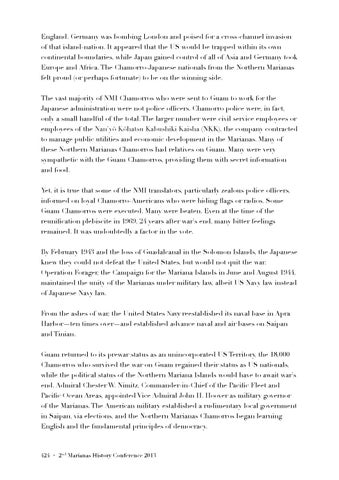England. Germany was bombing London and poised for a cross-channel invasion of that island-nation. It appeared that the US would be trapped within its own continental boundaries, while Japan gained control of all of Asia and Germany took Europe and Africa. The Chamorro-Japanese nationals from the Northern Marianas felt proud (or perhaps fortunate) to be on the winning side.
!
The vast majority of NMI Chamorros who were sent to Guam to work for the Japanese administration were not police officers. Chamorro police were, in fact, only a small handful of the total. The larger number were civil service employees or employees of the Nan’yō Kōhatsu Kabushiki Kaisha (NKK), the company contracted to manage public utilities and economic development in the Marianas. Many of these Northern Marianas Chamorros had relatives on Guam. Many were very sympathetic with the Guam Chamorros, providing them with secret information and food.
!
Yet, it is true that some of the NMI translators, particularly zealous police officers, informed on loyal Chamorro-Americans who were hiding flags or radios. Some Guam Chamorros were executed. Many were beaten. Even at the time of the reunification plebiscite in 1969, 24 years after war’s end, many bitter feelings remained. It was undoubtedly a factor in the vote.
!
By February 1943 and the loss of Guadalcanal in the Solomon Islands, the Japanese knew they could not defeat the United States, but would not quit the war. Operation Forager, the Campaign for the Mariana Islands in June and August 1944, maintained the unity of the Marianas under military law, albeit US Navy law instead of Japanese Navy law.
!
From the ashes of war, the United States Navy reestablished its naval base in Apra Harbor—ten times over—and established advance naval and air bases on Saipan and Tinian.
!
Guam returned to its prewar status as an unincorporated US Territory, the 18,000 Chamorros who survived the war on Guam regained their status as US nationals, while the political status of the Northern Mariana Islands would have to await war’s end. Admiral Chester W. Nimitz, Commander-in-Chief of the Pacific Fleet and Pacific Ocean Areas, appointed Vice Admiral John H. Hoover as military governor of the Marianas. The American military established a rudimentary local government in Saipan, via elections, and the Northern Marianas Chamorros began learning English and the fundamental principles of democracy.
!
424 ! ・ 2nd Marianas History Conference 2013
